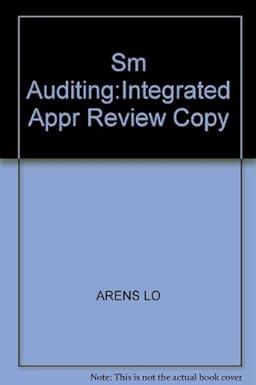Question
1) Which of the following is not an example of a decision or informed judgment that a potential investor would make from accounting information? Select
1) Which of the following is not an example of a decision or informed judgment that a potential investor would make from accounting information?
Select one:
a. Future profitability based on past profitability.
b. Probability of success of a new product development.
c. A forecast of dividends.
d. Assessment of risk that a company may have more debt than it can repay if the economy enters a recession.
2) Paid-in Capital represents:
Select one:
a. earnings retained for use in the business.
b. the amount invested in the entity by the stockholders.
c. fair value of the entity's common stock.
d. net assets of the entity at the date of the statement.
3) The balance sheet of an entity:
Select one:
a. shows the fair value of the assets at the date of the balance sheet.
b. reflects the impact of inflation on the replacement cost of the assets.
c. reports plant and equipment at its opportunity cost.
d. shows amounts that are not adjusted for changes in the purchasing power of the dollar.
4) The principle of consistency means that:
Select one:
a. the accounting methods used by an entity never change.
b. the same accounting methods are used by all firms in an industry.
c. the effect of any change in an accounting method will be disclosed in the financial statements or notes thereto.
d. there are no alternative methods of accounting for the same transaction.
5) Accumulated depreciation on a balance sheet:
Select one:
a. is part of stockholders' equity.
b. represents the portion of the cost of an asset that is assumed to have been "used up" in the process of operating the business.
c. represents cash that will be used to replace worn out equipment.
d. recognizes the economic loss in value of an asset because of its age or use.
6) When comparing entity financial ratios with industry ratios:
Select one:
a. it should be assumed that the data result from the consistent application of alternative accounting methods.
b. relative values at a point in time may not be significant.
c. the trend of entity ratios should be compared to the current year's industry ratio.
d. entity ratios should not be compared with industry ratios.
7) Another term for return on investment is:
Select one:
a. Return on equity.
b. Return on assets.
c. Return on retained earnings.
d. Return to sender.
8) A leveraged buyout refers to:
Select one:
a. one firm issues stock to take over another firm.
b. one firm trades its stock for the stock of another firm.
c. a firm goes heavily into debt in order to obtain the funds to purchase the shares of the public stockholders and thus take the firm private.
d. one firm pays cash for the shares of a takeover firm's shares.
9)Management's use of resources can best be evaluated by focusing on measures of:
Select one:
a. liquidity.
b. activity.
c. leverage.
d. book value.
10) Which of the following is not a category of financial statement ratios?
Select one:
a. Financial leverage.
b. Liquidity.
c. Profitability.
d. Prospectus.
11) An individual interested in making a judgment about the profitability of a company should:
Select one:
a. review the trend of working capital for several years.
b. calculate the company's ROI for the most recent year.
c. review the trend of the company's ROI for several years.
d. compare the company's ROI for the most recent year with the industry average ROI for the most recent year.
12) The Interest Receivable account for February showed transactions totaling $8,500 and an adjustment of $11,200.
Select one:
a. The transactions probably resulted from accruing interest income earned.
b. The transactions were probably entered on the credit side of the account.
c. The adjustment was probably for cash receipts of interest receivable accrued in prior months.
d. The balance in the interest receivable account decreased $2,700.
13) When a firm purchases supplies for its business:
Select one:
a. the supplies account should always be debited.
b. the supplies expense account should always be debited.
c. either the supplies account or the supplies expense account should be credited.
d. an adjustment will probably be required as supplies are used.
Step by Step Solution
There are 3 Steps involved in it
Step: 1

Get Instant Access to Expert-Tailored Solutions
See step-by-step solutions with expert insights and AI powered tools for academic success
Step: 2

Step: 3

Ace Your Homework with AI
Get the answers you need in no time with our AI-driven, step-by-step assistance
Get Started


